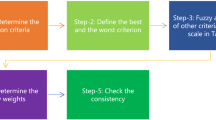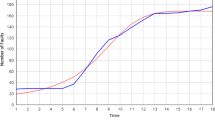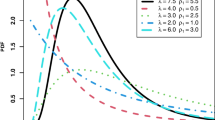Abstract
A method for reliability analysis of the competing failure with the probabilistic failure threshold value not the fixed threshold value is presented, which involves the random shocks and the degradation is independent and dependent respectively. Specifically, for the dependent condition, the effect due to the random shocks on the degradation is considered with a damage factor. In addition, the dependent competing failure model is applied to the reliability analysis of the k-out-of-n systems. Finally, two studied cases are presented to illustrate the proposed method, and the results show the proposed method is reasonable.
Similar content being viewed by others
References
Alessandro B. Reliability engineering: Theory and practice [M]. New York USA: Springer, 2010.
Jiang L, Feng Q M, Coit D W. Reliability and maintenance modeling for dependent competing failure processes with shifting failure thresholds [J]. IEEE Transactions on Reliability, 2012, 61(4): 932–948.
Klutke G A, Yang Y J. The availability of inspected systems subject to shocks and graceful degradation [J]. IEEE Transactions on Reliability, 2002, 51(3): 371–374.
Wang Y P, Pham H. Modeling the dependent competing risks with multiple degradation processes and random shock using time-varying copulas [J]. IEEE Transactions on Reliability, 2012, 61(1): 13–22.
Li W J, Pham H. Reliability modeling of multi-state degraded systems with multi-competing failures and random shocks [J]. IEEE Transactions on Reliability, 2005, 54 (2): 297–303.
Huang W, Askin R G. Reliability analysis of electronic devices with multiple competing failure modes involving performance aging degradation [J]. Quality and Reliability Engineering International, 2003, 19: 241–254.
Peng H, Feng Q, Coit D W. Reliability and maintenance modeling for systems subject to multiple dependent competing failure processes [J]. IIE Transactions, 2011, 43: 12–22.
Chen J Y, Li Z H. An extended extreme shock maintenance model for a deteriorating system [J]. Reliability Engineering and System Safety, 2008, 93: 1123–1129.
Mallor F, Santos J. Reliability of systems subject to shocks with a stochastic dependence for the damages [J]. Test, 2003, 12(2): 427–444.
Li Z H, Zhao P. Reliability analysis on the d-shock model of complex systems [J]. IEEE Transactions on Reliability, 2007, 56(2): 340–348.
Sgarbossa F, Pham H. A cost analysis of systems subject to random field environments and reliability [J]. IEEE Transactions on Systems, Man, and Cybernetics. Part C. Application and Reviews, 2010, 40(4): 429–437.
Nakagawa T. Shock and damage models in reliability theory [M]. London UK: Springer, 2007.
Robinson M E, Crowder M J. Bayesian methods for a growth-curve degradation model with repeated measures [J]. Lifetime Data Analysis, 2000, 6: 357–374.
Yuan X X, Pandey M D. A nonlinear mixed-effects model for degradation data obtained from in-service inspections [J]. Reliability Engineering and System Safety, 2009, 94: 509–519.
Nicolai R P, Dekker R, van Noortwijk J M. A comparison of models for measurable deterioration: An application to coatings on steel structures [J]. Reliability Engineering and System Safety, 2007, 92: 1635–1650.
Xue J, Yang K. Dynamic reliability analysis of coherent multistate systems [J]. IEEE Transactions on Reliability, 1995, 44(4): 683–688.
Huang W, Dietrich D L. An alternative degradation reliability modeling approach using maximum likelihood estimation [J]. IEEE Transactions on Reliability, 2005, 54(2): 310–317.
Lu C J, Meeker W Q. Using degradation measures to estimate a time-to-failure distribution [J]. Technometrics, 1993, 35(2): 161–174.
Pham H. On the optimal design of k-out-of-n subsystems [J]. IEEE Transactions on Reliability, 1992, 41(4): 572–574.
Pham H, Wang H. Optimal (t, T) opportunistic maintenance of a k-out-of-n: G system with imperfect PM and partial failure [J]. Naval Research Logistics, 2000, 47: 223–239.
Liu Y, Huang H Z, Pham H. Reliability evaluation of systems with degradation and random shocks [C]// Proceedings of the Reliability and Maintainability Symposium. Las Vegas USA: IEEE, 2008: 328–333.
Author information
Authors and Affiliations
Corresponding author
Additional information
Foundation item: the Special Research Fund for the National Natural Science Foundation of China (No. 11272082), the Fundamental Research Funds for the Central Universities (No. E022050205) and the Open Research Fund of Key Laboratory of Fluid and Power Machinery of Xihua University (No. szjj2013-03)
Rights and permissions
About this article
Cite this article
Yuan, R., Li, Hq., He, Lp. et al. Reliability analysis for the competing failure with probabilistic failure threshold value and its application to the k-out-of-n systems. J. Shanghai Jiaotong Univ. (Sci.) 20, 500–507 (2015). https://doi.org/10.1007/s12204-015-1657-0
Received:
Published:
Issue Date:
DOI: https://doi.org/10.1007/s12204-015-1657-0




